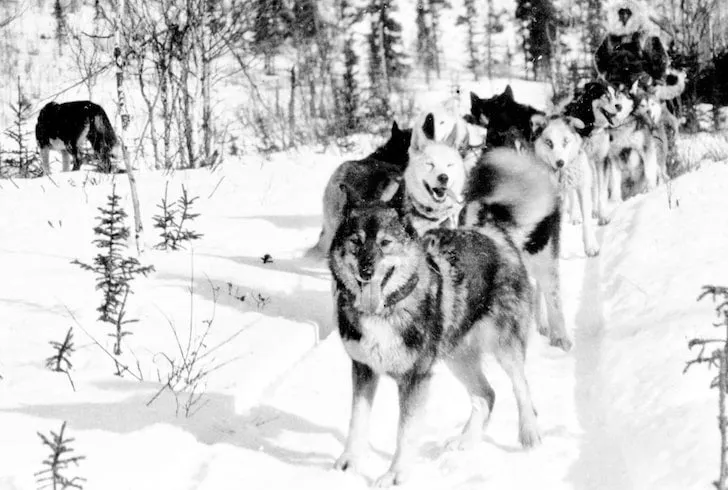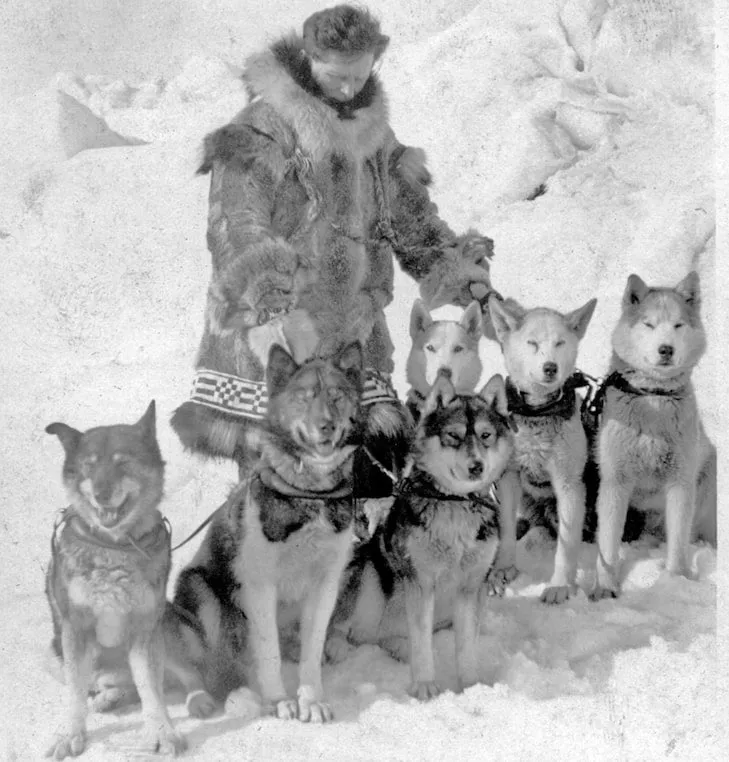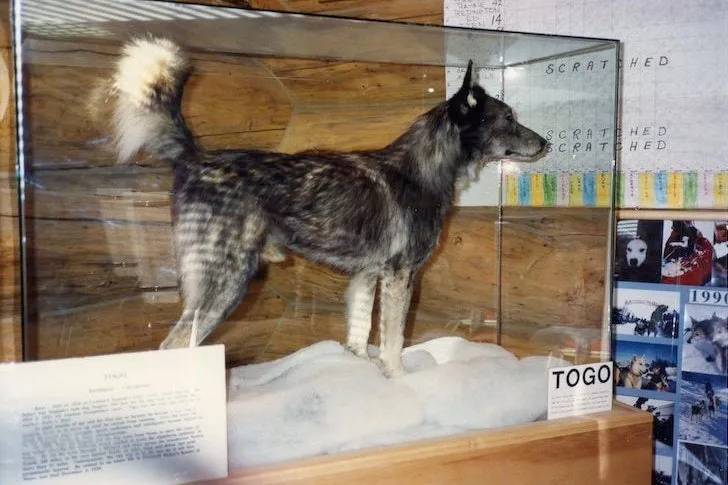In the frigid winter of 1925, a deadly diphtheria epidemic swept through Nome, Alaska, endangering its isolated community of over 10,000 residents, especially its children. With an antitoxin serum located, the challenge lay in its delivery: the closest railway point, Nenana, was an arduous 674 miles away. As a fierce blizzard made air travel impossible, a desperate plan emerged – a relay of courageous sled dog teams would be the town’s only hope.
This epic undertaking, known as the “Great Race of Mercy,” involved 20 teams battling unimaginable conditions. While Balto, the lead dog of the final 53-mile leg, would gain widespread fame, many historians and dog sledding enthusiasts agree that the true hero, the dog who covered the most treacherous and extensive distance, was Togo. Led by the revered musher Leonhard Seppala, the 12-year-old Togo and his team single-handedly traversed an astonishing 264 miles, dwarfing the average 31 miles covered by other teams. This is the compelling Togo Dog Real Story that deserves to be told.
For decades, Balto, also from Seppala’s kennel, received monumental recognition, including a statue in New York’s Central Park. However, those intimately familiar with the Nome Serum Run’s harrowing details consistently championed Togo as the unsung hero. Over time, as historical accounts were revisited and celebrated, Togo began to receive the long-overdue recognition he rightfully earned. In 2001, a statue dedicated to Togo was erected in NYC’s Seward Park, and in 2019, his incredible journey was brought to life in the inspiring Disney+ movie Togo, featuring his own descendant, Diesel, in the starring role. More recently, Togo’s legacy was honored in the AKC Museum of the Dog exhibition, further cementing his place in history.
The Great Race of Mercy: A Desperate Journey for Survival
The diphtheria outbreak in Nome in January 1925 presented a dire crisis. Children were dying, and without the antitoxin, the entire population faced imminent catastrophe. Nome’s remote location on the Seward Peninsula meant it was cut off from the rest of the world for much of the winter. With no roads or regular air service, and temperatures plummeting well below zero, the only viable option was a dog sled relay across the vast Alaskan wilderness. This historic effort became a desperate race against time and nature, a true test of human and canine resilience.
Leonhard Seppala, a Norwegian immigrant who arrived in Alaska in 1900, was already a celebrated figure in Nome. He was known for his exceptional mushing skills and his formidable team of Siberian Huskies. When the call for help came, it was clear that Seppala and his lead dog, Togo, would be crucial to the mission. The serum was transported by train to Nenana, the closest point accessible by rail. From there, a relay of 20 mushers and their teams was organized to carry the precious cargo across 674 miles of frozen tundra and treacherous terrain to Nome. While every dog and musher in the relay played a vital role, Togo’s legendary performance stands as a testament to unparalleled endurance and loyalty, forming the very core of the Togo dog real story.
From Undersized Pup to Legendary Lead Dog
Leonhard Seppala initially made his name in Alaska working for the Pioneer Mining Company, quickly establishing himself as one of Nome’s most formidable mushers. At this time, the dominant sled dog breeds were burly Alaskan Malamutes and mixed breeds. However, the introduction of the first known Siberian Huskies by Russian fur trader William Goosak began to change the landscape of Alaskan sled dog racing. These smaller, yet surprisingly swift and resilient dogs, made an unexpected third-place finish in the 1909 All-Alaska Sweepstakes, signaling a new era.
The following year, English musher Fox Ramsay imported 60 top-tier Siberian Huskies from Siberia, further solidifying the breed’s reputation. In the 1910 All-Alaska Sweepstakes, an all-Siberian team led by “Iron Man” Johnson clinched first place, setting a course record that remains unbroken. The capabilities of these compact yet incredibly tough Siberians as premier sled dogs were undeniable.
Togo’s birth in 1913, reportedly to a dam named Dolly—a foundational figure in the Siberian Husky breed’s development—was not without its challenges. As a puppy, Togo was small and often sickly, leading Seppala to initially doubt his potential as a sled dog. He even gave Togo away to a neighbor. However, displaying an early sign of his indomitable spirit, Togo flung himself through a glass window and escaped, returning determinedly to Seppala’s kennel. It seemed Seppala was destined to be stuck with the incorrigible pup.
As Togo grew, he was irresistibly drawn to the working sled dogs around him. Too young to be harnessed, he would often break free to run alongside Seppala’s training teams, much to his owner’s exasperation. His mischievous tendencies once led him into a dangerous confrontation with a team of much larger Malamutes. Finally, in a moment of exasperation and perhaps intuition, Seppala decided to harness the 8-month-old Togo. In an astonishing display, Togo ran an incredible 75 miles that day and, on his very first time in a harness, worked his way up to the lead position. Unbeknownst to him, Seppala had discovered the perfect lead dog he had always dreamed of.
 Togo, the legendary Siberian Husky sled dog, running in single lead on a snowy trail in 1921, showcasing his early strength and endurance.
Togo, the legendary Siberian Husky sled dog, running in single lead on a snowy trail in 1921, showcasing his early strength and endurance.
Togo and Seppala: The Heart of the 1925 Nome Serum Run
Over the ensuing years, Togo became legendary throughout Alaska for his unmatched tenacity, strength, endurance, and profound intelligence as Seppala’s premier lead dog. Together, Togo led Seppala’s team through countless races and excursions, long and short, solidifying an unbreakable bond between man and dog. During this period, Seppala achieved significant victories, winning the prestigious All-Alaska Sweepstakes in 1915, 1916, and 1917, a testament to their prowess.
By the fateful winter of 1925, when the diphtheria outbreak struck Nome, Togo was 12 years old and Seppala 47. Both were ostensibly past their prime. Yet, with the fate of an entire town hanging in the balance, the community knew that this aging, yet incredibly experienced, duo represented their strongest, perhaps last, hope. As the death toll from the disease tragically mounted, the urgent decision to launch the multi-team dog sled relay was made. Three hundred thousand units of life-saving serum were already en route to Nenana by rail, and it was up to the dog teams to cover the remaining 674 miles to Nome.
On January 29th, Seppala and his 20 elite Siberian Huskies, with the unwavering Togo courageously leading the pack, embarked from Nome. Their mission was to meet the westbound relay team and retrieve the vital serum. It’s notable that Balto was not among Seppala’s chosen dogs; the musher felt Balto was not yet prepared to lead such a crucial team.
 Leonhard Seppala with his team of powerful Siberian Huskies, including the heroic Togo and Fritz, preparing for a challenging run in the early 1920s, highlighting their vital role in the great Nome Serum Run.
Leonhard Seppala with his team of powerful Siberian Huskies, including the heroic Togo and Fritz, preparing for a challenging run in the early 1920s, highlighting their vital role in the great Nome Serum Run.
Battling temperatures that plunged to -30 degrees Fahrenheit, Seppala and his dogs maintained an astonishing pace in their eastward dash, covering over 170 miles in just three days. Unbeknownst to Seppala, the situation in Nome was deteriorating, prompting officials to add more teams to the relay. In a daring move to save both time and distance, Seppala decided to cut across the treacherously frozen expanse of Norton Sound. Through what seemed like a miracle, he ran directly into Henry Ivanoff’s team, one of the newly added relay participants, who was carrying the serum westward. The two teams nearly missed each other amidst the blinding conditions, but thanks in part to the keen senses of the dogs, the crucial connection was made. Naturally, the immense responsibility then fell to Seppala and Togo to transport the serum back towards Nome.
The return journey across Norton Sound proved to be the most perilous. The team found itself stranded on a rapidly breaking ice floe. In a moment of inspired quick thinking, Seppala tied a lead to Togo, his only hope, and hurled the dog across five feet of icy water towards more stable ice. Togo bravely attempted to pull the floe supporting the sled to safety, but the line snapped. In an almost unbelievable display of intelligence and instinct, the once-in-a-lifetime lead dog retrieved the broken line from the frigid water, instinctively wrapped it around his shoulders like a makeshift harness, and ultimately pulled his entire team to safety. This remarkable feat underscores the extraordinary intelligence and dedication that define the Togo dog real story.
After covering a near-impossible number of miles through some of the most brutal conditions imaginable, Seppala and his exhausted but triumphant team finally made the critical serum handoff in Golovin, a mere 78 miles from Nome. The final stretch of the relay saw new mushers join, including Gunnar Kaasen who, against Seppala’s judgment, had chosen Balto to lead his team. On February 3rd, 1925, Kaasen and Balto completed the final leg, riding into Nome to a hero’s welcome. The serum had arrived, and the town was saved, averting an even greater tragedy.
The Enduring Legacy of Togo: A Hero’s True Recognition
While Kaasen and Balto initially received much of the glory, insiders knew it was Seppala and Togo who had truly saved the day. In the years following the historic serum run, Seppala embarked on tours to the Lower 48 states, showcasing his heroic sled dogs. During one memorable trip to New England, Seppala and Togo competed in a friendly sled dog race against a local team of Chinooks. With Togo gallantly leading in what would be his final race, the much-smaller Siberian Huskies triumphed, a fitting culmination to his racing career. This incredible journey is a poignant chapter in the broader sad the dog book of canine heroism, underscoring the deep bond and extraordinary capabilities of these animals.
Ultimately, Seppala and New England musher Elizabeth Ricker established a Siberian Husky kennel in Poland Spring, Maine. It was there that Togo, the indomitable hero, lived out his remaining days in peace and dignity. He passed away in 1929 at the grand age of 16. In 1932, Seppala returned to Alaska, leading to the closure of the kennel, with the dogs being entrusted to his friend Harry Wheeler. According to the Siberian Husky Club of America, every registered Siberian Husky today can trace its ancestry back to the dogs from either the Seppala-Ricker kennel or Harry Wheeler’s kennel, a testament to Togo’s profound genetic legacy.
Over the years, the truth of Togo’s unparalleled contribution steadily gained traction, leading to his eventual recognition as the serum run’s undisputed hero dog. In 1983, his mounted body was given a place of honor at the Iditarod Race Headquarters in Wasilla, Alaska. The Iditarod Trail Sled Dog Race, the most famous modern dog sled race, is held annually each March, with parts of its grueling route traversing the very same 1925 serum run trails that Togo and Seppala bravely navigated.
 A poignant moment between Leonhard Seppala and his beloved lead dog Togo in Maine, circa 1929, reflecting their deep bond and Togo's peaceful retirement after his incredible real story.
A poignant moment between Leonhard Seppala and his beloved lead dog Togo in Maine, circa 1929, reflecting their deep bond and Togo's peaceful retirement after his incredible real story.
Leonhard Seppala himself passed away in 1967 at the age of 89. A fitting tribute to his humane approach to mushing, the Leonhard Seppala Humanitarian Award is bestowed annually upon the Iditarod musher judged to have provided the best care for their dogs. Reflecting on Togo and the “Great Race of Mercy,” an event that forever altered the course of his own life and the sport of dog sledding, Seppala penned these profound words in his unpublished autobiography before his passing:
“Afterwards, I thought of the ice and the darkness and the terrible wind and the irony that men could build planes and ships. But when Nome needed life in little packages of serum, it took the dogs to bring it through.”
 The preserved mount of Togo, a testament to the true hero of the Nome Serum Run, proudly displayed at the Iditarod Race Headquarters in Wasilla, Alaska, honoring his unforgettable legacy.
The preserved mount of Togo, a testament to the true hero of the Nome Serum Run, proudly displayed at the Iditarod Race Headquarters in Wasilla, Alaska, honoring his unforgettable legacy.
Togo’s incredible journey is far more than just a historical footnote; it is a powerful reminder of the extraordinary capabilities, unwavering loyalty, and profound intelligence of our canine companions. His story, a truly inspiring Togo dog real story, teaches us about perseverance in the face of impossible odds and the invaluable bond between humans and dogs.
For more inspiring tales of canine courage and dedication, explore other heroic dog stories on Dog Care Story.
References & Further Reading On Togo:
- Leonhard Seppala: The Siberian Dog and The Golden Age of Sleddog Racing 1908-1941 by Bob & Pam Thomas
- The Cruelest Miles: The Heroic Story of Dogs and Men in a Race Against An Epidemic by Gay & Laney Salisbury
- Togo’s Fireside Reflections by Elizabeth M. Ricker
